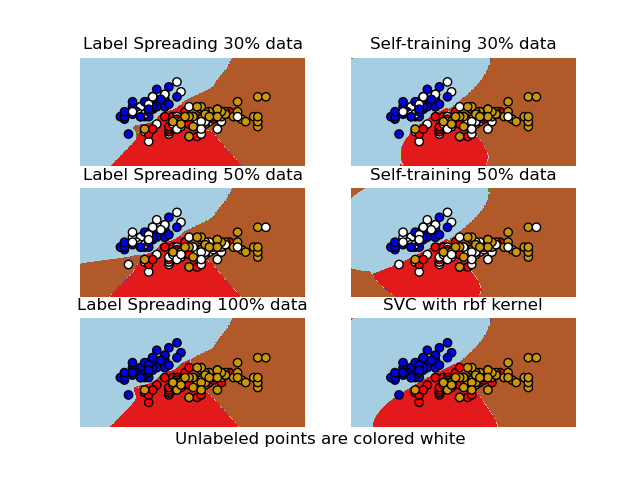Nota
Haz clic aquí para descargar el código completo del ejemplo o para ejecutar este ejemplo en tu navegador a través de Binder
Frontera de decisión de los clasificadores semisupervisados en comparación a SVM en el conjunto de datos Iris¶
Comparación de las fronteras de decisión generadas en el conjunto de datos iris mediante Propagación de etiquetas, autoentrenamiento y SVM.
Este ejemplo demuestra que Label Spreading —la dispersión de etiquetas— y Self-training —el autoentrenamiento— pueden aprender buenas fronteras incluso cuando se dispone de pequeñas cantidades de datos etiquetados.
Ten en cuenta que se ha omitido el autoentrenamiento con el 100% de los datos, ya que es funcionalmente idéntico al entrenamiento del SVC con el 100% de los datos.

print(__doc__)
# Authors: Clay Woolam <clay@woolam.org>
# Oliver Rausch <rauscho@ethz.ch>
# License: BSD
import numpy as np
import matplotlib.pyplot as plt
from sklearn import datasets
from sklearn.svm import SVC
from sklearn.semi_supervised import LabelSpreading
from sklearn.semi_supervised import SelfTrainingClassifier
iris = datasets.load_iris()
X = iris.data[:, :2]
y = iris.target
# step size in the mesh
h = .02
rng = np.random.RandomState(0)
y_rand = rng.rand(y.shape[0])
y_30 = np.copy(y)
y_30[y_rand < 0.3] = -1 # set random samples to be unlabeled
y_50 = np.copy(y)
y_50[y_rand < 0.5] = -1
# we create an instance of SVM and fit out data. We do not scale our
# data since we want to plot the support vectors
ls30 = (LabelSpreading().fit(X, y_30), y_30, 'Label Spreading 30% data')
ls50 = (LabelSpreading().fit(X, y_50), y_50, 'Label Spreading 50% data')
ls100 = (LabelSpreading().fit(X, y), y, 'Label Spreading 100% data')
# the base classifier for self-training is identical to the SVC
base_classifier = SVC(kernel='rbf', gamma=.5, probability=True)
st30 = (SelfTrainingClassifier(base_classifier).fit(X, y_30),
y_30, 'Self-training 30% data')
st50 = (SelfTrainingClassifier(base_classifier).fit(X, y_50),
y_50, 'Self-training 50% data')
rbf_svc = (SVC(kernel='rbf', gamma=.5).fit(X, y), y, 'SVC with rbf kernel')
# create a mesh to plot in
x_min, x_max = X[:, 0].min() - 1, X[:, 0].max() + 1
y_min, y_max = X[:, 1].min() - 1, X[:, 1].max() + 1
xx, yy = np.meshgrid(np.arange(x_min, x_max, h),
np.arange(y_min, y_max, h))
color_map = {-1: (1, 1, 1), 0: (0, 0, .9), 1: (1, 0, 0), 2: (.8, .6, 0)}
classifiers = (ls30, st30, ls50, st50, ls100, rbf_svc)
for i, (clf, y_train, title) in enumerate(classifiers):
# Plot the decision boundary. For that, we will assign a color to each
# point in the mesh [x_min, x_max]x[y_min, y_max].
plt.subplot(3, 2, i + 1)
Z = clf.predict(np.c_[xx.ravel(), yy.ravel()])
# Put the result into a color plot
Z = Z.reshape(xx.shape)
plt.contourf(xx, yy, Z, cmap=plt.cm.Paired)
plt.axis('off')
# Plot also the training points
colors = [color_map[y] for y in y_train]
plt.scatter(X[:, 0], X[:, 1], c=colors, edgecolors='black')
plt.title(title)
plt.suptitle("Unlabeled points are colored white", y=0.1)
plt.show()
Tiempo total de ejecución del script: (0 minutos 1.680 segundos)
